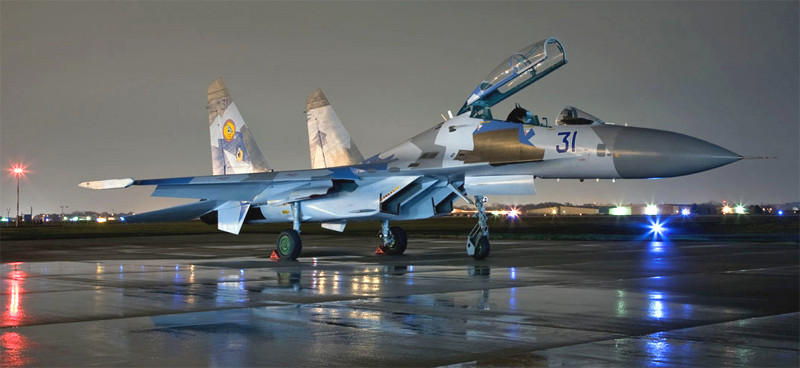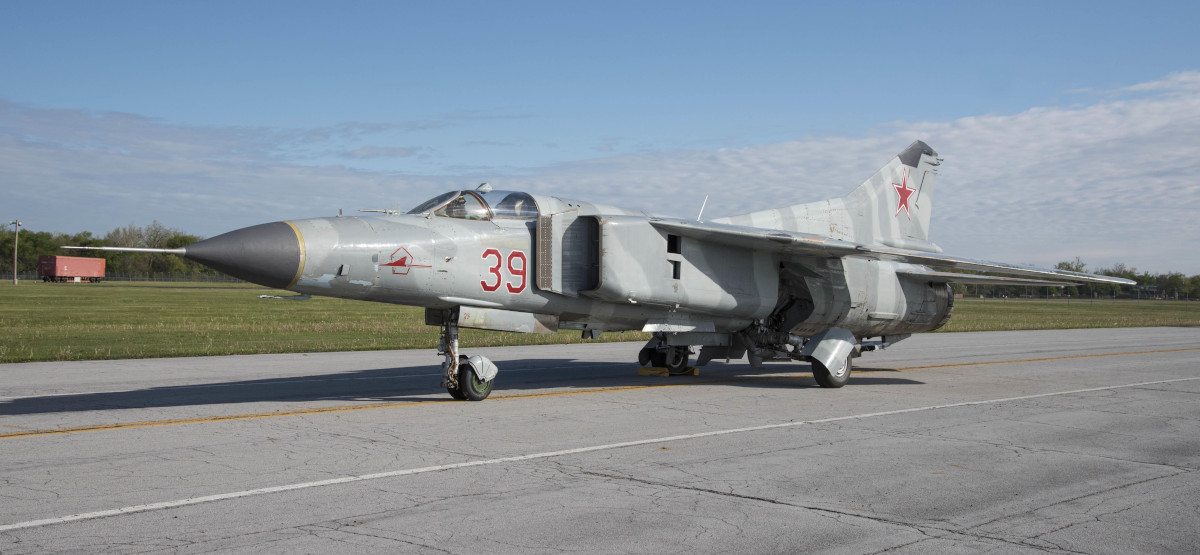The U.S. Air Force’s famed museum in Dayton, Ohio has acquired a Soviet-designed Sukhoi Su-27 Flanker. This is hardly the first time its had gotten a foreign-made, once adversarial aircraft to put on display. However, this jet, a two-seat Su-27UB Flanker-C, has a famously murky history and is widely believed to have spent the last decade or so in the top-secret world of what the U.S. military calls Foreign Material Exploitation, or FME, quite likely out at Area 51.
The National Museum of the U.S. Air Force announced the acquisition of the Su-27UB on social media today and released pictures of the aircraft sitting outside one of its hangars. Though a full view of the Flanker-C is not provided, the aircraft’s particular camouflage scheme and Soviet-style ‘bort’ number of the nose – Blue 32 – are identical to those found on one that had been on the U.S. civil register as N132SU for a number of years.

N132SU was first registered with the Federal Aviation Administration (FAA) in 2009. The jet and a second Su-27UB, which was registered as N131SU, were purchased on the open market from Ukraine and subsequently put up for sale in the United States by a company then called Pride Aircraft, Inc.

The Su-27s were the first available for sale to a civilian in the United States and drew a lot of attention and interest. Pride Aircraft widely publicized such a unique offering and the progress being made readying them for sale. The price?Just under $5M per jet — a steal when you think about it now.
Both Flankers were in very good condition having received much care in Ukraine, including zero time engines, before being shipped to the U.S. via An-124 airlifter. More work was done by Pride to fully demilitarize the jets and prepare them for a new buyer that would own the highest performance jet warbird, or warbirds, ever sold to a private individual in the United States.
Then everything went dark.

Sometime between March and April 2011, that company updated its website to say that both aircraft had been sold, but did not say to who and nobody knew of any major collector or operator who purchased them. It was a widely discussed mystery in warbird and military aviation circles.
Then N131SU and N132SU, both of which were officially registered to a company in Delaware called Meridican, Inc., fell completely out of public view. FAA’s website says it only canceled those registrations in 2018 when they expired, but does not provide any additional as to who has been operating the jets over the years or what happened to them afterward.
The War Zone has reached out to the National Museum of the U.S. Air Force and Meridican Capital, which appears related to Meridican, Inc. Meridican Capital, which has offices in Philadelphia, Pennsylvania, and San Francisco Franciso, California, describes itself as an “investments and advisory services” firm focused on the aerospace and defense industries, among other things.

Private “red air” adversary support contractor Tactical Air Support, or TacAir, may have had a hand in operating one or both of these jets for a time. The company’s website does have an Su-27 aircraft page and says elsewhere that “we operate, or have operated, customer-owned aircraft up to, and including fourth-generation fighter aircraft such as the F-16 and SU-27.”
For years on its website, even after the jets had been sold, Pride Aircraft dismissed as nothing more than “rumors and whispers” that the two Su-27s would be used for any kind of military purpose. Yet nobody had seen these giant fighters since they disappeared off Pride Aircraft’s ramp. They vanished completely.
However, it is widely believed that the two ex-Ukrainian Flanker-Cs made their way into the U.S. military’s FME ecosystem and to the Air Force’s secretive Groom Lake test facility, better known as Area 51. FME involves the acquisition through various means, including open sale via ‘cutout’ entities, of foreign aircraft and other materiel for very deep hands-on intelligence analysis, including testing and reverse engineering, as you can read more about here.
Since the end of the Cold War, Ukraine has been an important source for the United States for Soviet-designed weapon systems, including aircraft, and other equipment. The country has more recently provided valuable examples of more modern Russian materiel as a byproduct of the current conflict there.
Aircraft, in particular, acquired for FME purposes are often also utilized for test and evaluation and training purposes. Having actual examples of threat-representative jets and other weapon systems offers an extremely valuable level of realism that cannot be achieved through simulations and surrogates. Just seeing a real foreign adversary aircraft up close for the first time in simulated combat can offer major advantages, including getting over ‘buck fever’ caused by actually encountering the thing you have trained so hard to defeat.
For decades now, the Air Force has acquired and maintained an evolving fleet of foreign combat jets for FME and related activities. The service’s squadron responsible for actually flying these aircraft today, a fleet believed to include Su-27s and MiG-29 Fulcrums, is known by the nickname the Red Hats and is understood to be based at Area 51.


In 2017, U.S. Air Force Lt. Col. Eric “Doc” Schultz, who was potentially the commander of the Red Hats at the time, died in an accident near Area 51 involving an unknown aircraft. In 2022, author Steve Davies, citing multiple unnamed sources, provided a lengthy account of the incident in a video on his YouTube channel 10 Percent True, wherein he stated that Schultz had been at the controls of an Su-27UB Flanker-C at the time. Davies literally wrote the book on another top-secret Air Force FME squadron, the Red Eagles, which is heavily tied to the Red Hats.
The current status of the Flanker previously known as N131SU is unknown. There is no indication one way or the other that it was the aircraft involved in the 2017 crash, but it has not reappeared as its sister jet has.

So why would this once pristine Flanker come out of the darkness and into the light, at the USAF’s crown jewel of a museum no less? That is unclear. It is possible that the U.S. military’s needs for this Su-27UB has been met and/or whatever programs they were supporting have been shuttered. It’s also possible that it has been replaced with something else. Other factors could have put the aircraft out of action as well, such a over-stressing the airframe. We just don’t know at this time.
The Su-27 is much more of a known commodity now, regardless, and much of its capabilities and even its design can likely be digitally simulated. At the same time, as already noted, there is really no substitute for having real materiel to work with, which would have been why N132SU and its cousin were acquired in the first place.
No matter what, it is extremely interesting that this shadowy jet has reappeared after all these years at the National Museum of the U.S. Air Force. This would not be the first time an aircraft from the Air Force’s FME world has ended up in Dayton. Its MiG-23MS Flogger-E swing-wing combat jet is publicly acknowledged to have come from the Red Eagles’ fleet. Other examples of past FME aircraft, from MiG-21s to MiG-29s, are scattered around USAF installations.

What details now emerge about the history of the National Museum of the U.S. Air Force’s newly acquired Su-27 remain to be seen, but the fact that it has resurfaced after years of mystery is certainly a great twist in its already intriguing story.
The War Zone will definitely be following up with any new information we obtain.
Contact the author: joe@thedrive.com
